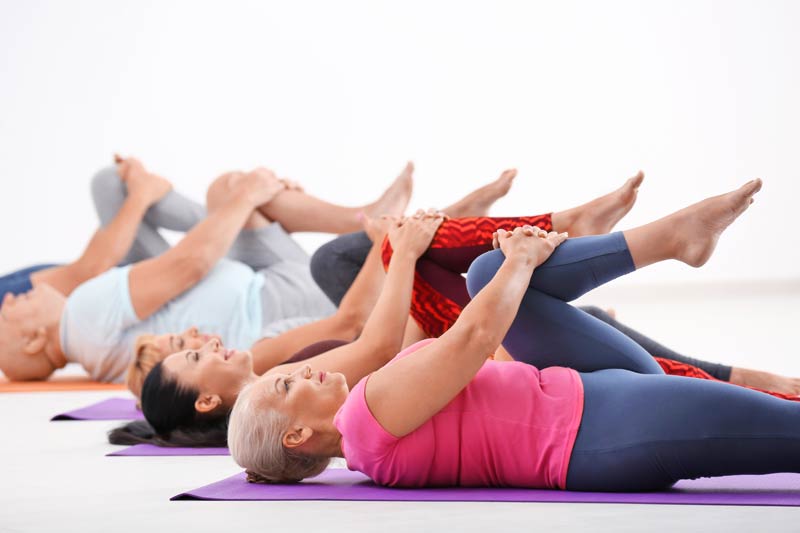
Yoga twists have many benefits beyond their physical appearance. They can also help with the mind because they can help you focus on your breathing and the centering process. A common twist involves compressing organs and forcing out blood full toxins and metabolic byproducts. When the twist is released, fresh blood flows in, carrying oxygen and building blocks for tissue healing. Doing yoga twists can improve circulation, and your body's ability stay centered in any activity.
When performing a twist, it is important to maintain your balance. Your goal is to maintain your balance and keep your torso straight. To help relax, you can practice a seated twist and keep your shoulders straight. To do a supine bend, your spine must be maintained at its natural length and curve. A balanced yoga pose requires deep breathing and balance.

Not only does it improve flexibility but also your spine. A healthy spine is essential to a healthy person. Increased blood flow can help your muscles absorb nutrients more effectively and speed up healing. When you are doing yoga, be mindful of your alignment. Proper hip alignment is essential to achieve the right alignment. A yoga instructor should explain proper technique and the proper twisting technique to you.
You can learn to twist by practicing correctly. Keep in mind that twists can be asymmetrical so it is important to align your body correctly. If you are able to sit upright, a twist should be performed with your legs firmly on the floor. If you have a flat lower back, you can sit on a blanket/block. Try to start the twist from your lower spine. This will prevent the neck from doing all the work, making the twist less prominent.
While twisting is relatively easy for beginners, it can be quite uncomfortable. It's not uncommon to feel pain when you first start a yoga class. In this case, it's important to start slowly and gradually. As you learn the basics of yoga you will soon notice a stronger core and improved flexibility. You'll soon be able perform twists that improve your posture and relieve pain as you learn more.

Before you can move to more complex twists, first practice standing and sitting versions of yoga to open up your spine. As you gain experience, your crown and tailbone can be extended to the ceiling. Before moving onto the next position, align your body correctly. You need to pay attention to the position of your pelvis while standing or sitting.
FAQ
How can you improve your wellbeing?
A person's well-being can be defined as their "state of mental, physical, spiritual, or social well-being". There are many factors that can impact our well-being. Your first step in improving well-being and your quality of life is to identify which areas need improvement. Then, work on changing these things.
Here are five tips to boost your well-being.
-
Exercise - It boosts endorphins, which can make us happier.
-
Sleep - More than 6 hours sleep per night can reduce stress and anxiety.
-
Nutrition - Eat healthy foods, such as fruits and veggies, to boost your mood.
-
Meditation – Meditation reduces stress and anxiety.
-
Socialization - It is important to spend quality time with our family and friends.
How can I improve my mental health?
Everyone needs mental health, especially when we feel stressed at work, school, home, or family. You can improve your mental health by exercising regularly, eating healthy foods, sleeping well, and spending quality time with family members. Exercise makes us feel happier and releases endorphins. Good nutrition is essential for a healthy body. Sleeping well gives us energy throughout the day. Spending quality times with loved one improves relationships and reduces stress.
Why is it so important to improve our emotional health?
Well-being and happiness are tied to emotional well-being. Your ability to perform at your highest level is dependent on how emotionally healthy you are. Depression can make it difficult for people to perform at their best. People with depression may also have anxiety, panic attacks and insomnia. These conditions can be successfully managed with medication and therapy.
Statistics
- It does have some influence, but not nearly as much as we might think, so focusing less on attaining wealth will likely make you happier (Aknin, Norton, & Dunn, 2009); (positivepsychology.com)
- More than 50% will be diagnosed with a mental illness or disorder at some point in their lifetime.3 (cdc.gov)
- More than 40 million adults in the United States have an anxiety disorder, but less than 37% of people seek mental health treatment for their symptoms. (talkspace.com)
- Similarly, for positive mental health, there is likely to be substantial agreement about some typical components (e.g., resilience to stress) 6, and controversy about more atypical components (e.g., career consolidation). (ncbi.nlm.nih.gov)
- According to the National Alliance of Mental Illness (NAMI), one in five Americans experiences mental health issues which translates to more than 40 million adults a year. (doctorondemand.com)
External Links
How To
How To Improve Your Memory
Everyone hopes to be able recall more about memory. Unfortunately, memory loss can happen to anyone at any time. In fact, more than half of Americans over 65 suffer from some form of dementia.
No matter if you are dealing with Alzheimer's disease, dementia or any other form of cognitive decline, there are many options to improve your memory. Here are three easy steps that you can start today:
-
Eat More Fruits & Vegetables. The antioxidants, vitamins, minerals and fiber found in fruits and vegetables can help boost brain function. They also provide essential nutrients that protect against neurological diseases.
-
Get Enough Sleep. Lack of sleep has been linked with memory loss and poor concentration. Get seven to eight hours of sleep each night.
-
Take A Walk. Walking stimulates blood flow to the brain, which improves memory. Walking makes you slimmer and healthier.